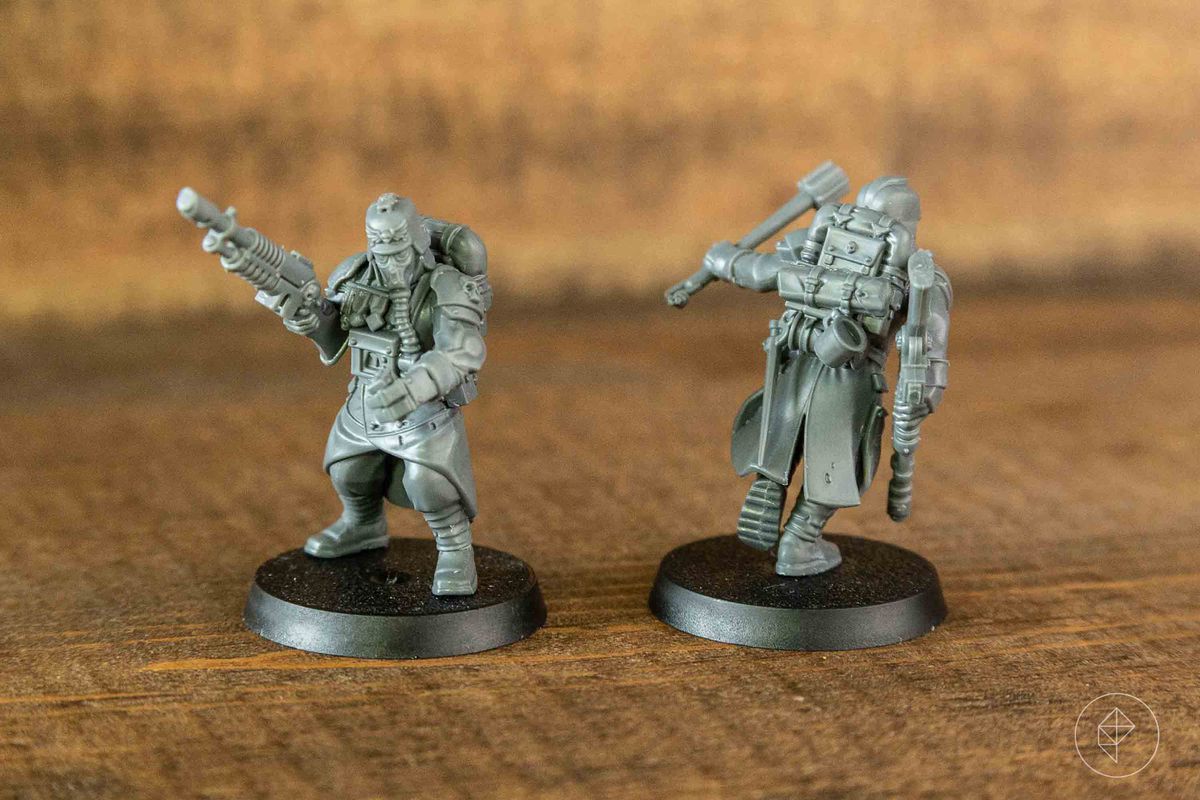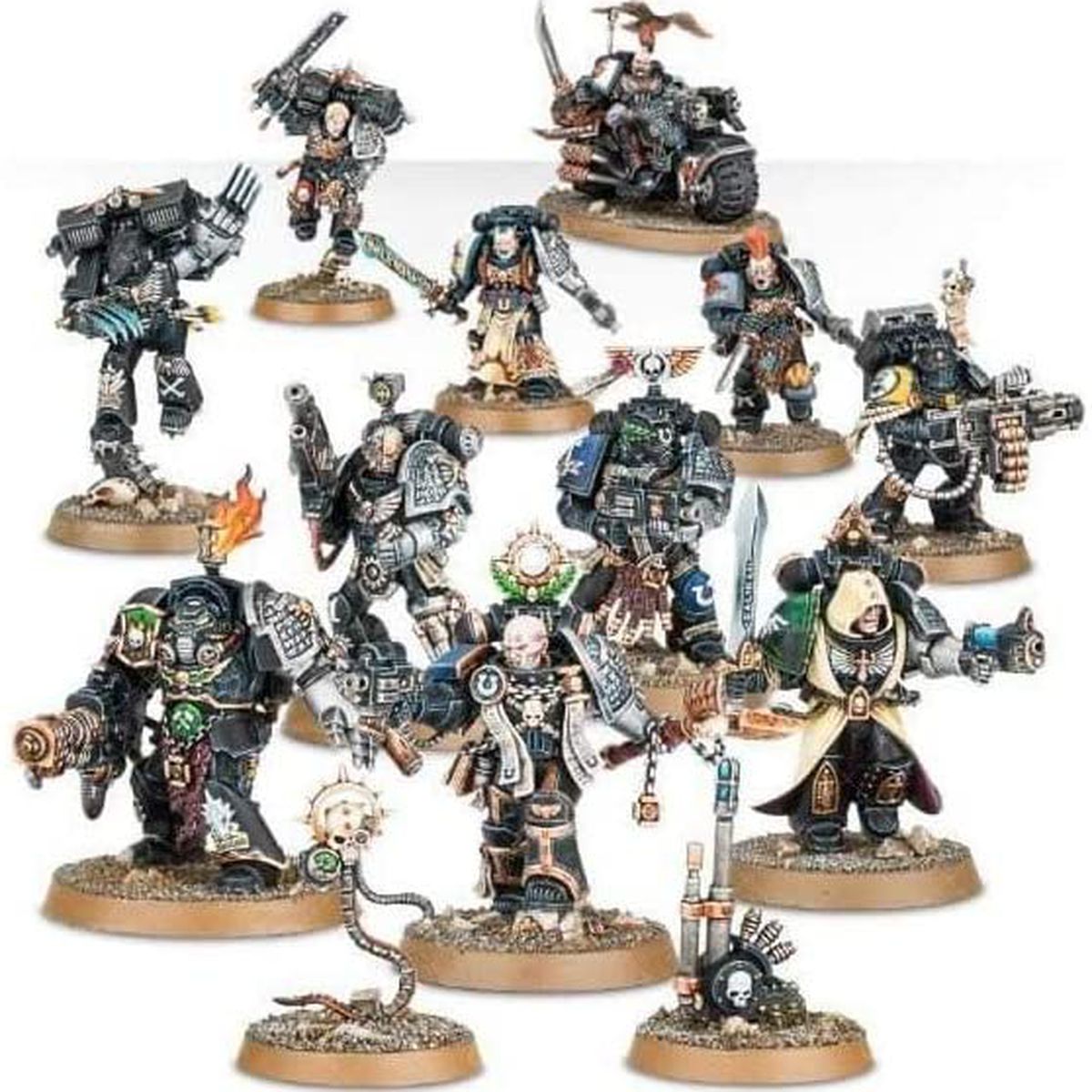Warhammer 40,000 Kill Team: Octarius is an extraordinary reboot for the struggling miniatures skirmish game. Once the sick man of the Games Workshop catalog, this lavish new boxed set could catapult the niche title into the mainstream. Octarius, and the Core Book that it comes with, succeeds at completely rebuilding the game’s notoriously wonky ruleset. It also adds in many more opportunities for narrative storytelling than almost any other title in the company’s catalog.
If you were looking for a reason to wade into the grim darkness of the far future, Octarius is the perfect place to get started.
Kill Team is a spinoff of the full-fat Warhammer 40,000 miniatures wargame. Instead of fielding armies with dozens of miniatures on each side of the table, Kill Team only requires a handful of figures and scenery to get started. Players sit down with a relatively tiny battlefield between them — just 22 inches by 30 inches on each side — and games can take as little as 45 minutes to play.
The Kill Team franchise was first launched in 2004, then rebooted first in 2018. That most recent version of the game tried very hard to use the same kind of unit statistics and gameplay turn structure as the mainline version of the tabletop wargame. That ultimately proved unwieldy, especially with each player moving and shooting before their opponent had a chance to respond. Compared to more nimble systems like Corvus Belli’s Infinity and the upcoming Cyberpunk Red: Combat Zone from Monster Fight Club, Kill Team felt ponderous and slow.
Photo: Games Workshop
Octarius’ new Core Book throws those legacy trappings right out the window, presenting players with an entirely new way to fight. Now, each individual model — not each player — takes its turn before moving on to the next. This results in much more fluid engagements, with back-and-forth battles that are far more cinematic in their execution.
Another key change comes to the action economy. Each unit on the map has a set action point limit, abbreviated to APL on their stat card. An action can be moving, firing a weapon, or assisting another unit on the board to perform a kind of combo — up to and including doling out more action points. Units also have unique actions that can only be performed by certain individuals, such as medics, explosive experts, and melee specialists. The result is something much closer to the elaborate tactical combat created for the 4th edition of Dungeons & Dragons, or something like Firaxis’ XCOM franchise, than anything else in the Games Workshop catalog.
The Core Book includes rules for three distinct modes of play, among them the traditional open (casual) and matched (competitive) formats. But the real treat here is a newly invigorated campaign mode called Spec Ops Narrative Play. This expanded mode encourages players to name their kill team and its individual members, developing an attachment and improving their skills over time.
Photo: Games Workshop
Units will earn experience every time they take the field — even while playing open and matched games. That experience can be used to add feats to a unit’s skillset that will make them even more capable and valuable. Players also have an off-map (read: invisible) base of operations, and can add to its capabilities over time. It’s catnip for dedicated hobbyists, who will be eager to create custom miniatures and terrain based on their battlefield exploits.
The boxed set itself is a much better value than the previous one (Warhammer 40,000 Kill Team: Pariah Nexus). While the final price point has yet to be announced, we expect it to come in around $150. Consumers will get two sets of models: the Death Korps of Krieg (vaguely German-looking troops wearing futuristic Pickelhaube and sporting long guns) and the hulking Ork Kommandos (who look like green powerlifters that just fought their way out of a junkyard). There’s also a ton of chunky, all-plastic terrain as well as dice, rulers, and cardboard tokens. This time around, Games Workshop even packed the included decks of cards inside tuck boxes, which will greatly improve their survivability in shipment. The gutter on the printed booklets is also much wider, meaning that you won’t have to tear the books in half to read them.
Photo: Games Workshop
Photo: Games Workshop
As far as the miniatures themselves, they’re all excellent sculpts, but I have some reservations about how they’ve been designed. While modders will have a field day with the Krieg, whose arms, hands, and heads will be easy to lop off and replace with just the right bits, the Kommandos are a little less fiddly. They’re easy enough to put together, but their poses and ornamentation will make them harder to transform into unique silhouettes. Also, the new rules allow up to 20 models in each kill team unit list. That means Octarius only comes with half the number of models you’ll need for matched play or an extended narrative campaign.

The real innovation here is the stand-alone Octarius book that comes bundled with the boxed set. While my copy showed up defective, with rumpled and creased pages throughout, it’s nonetheless a new and novel item. Much like a campaign module in D&D, it contains all the rules needed for these two factions to fight in a specific theater of war, as well as a connected series of unique missions.
Image: Games Workshop
It also includes detailed rules for each and every unit in the boxed set, and every piece of terrain as well. It’s the kind of clarity and precision that has simply been lacking from past Kill Zone terrain releases.
The only thing missing from the box, in my opinion — aside from helpful pack-ins to keep all of the components sorted and accessible — are blank unit lists. It’s frustrating that, in addition to spending hours painting and assembling the miniatures, I also have to create my own player aids on an inkjet printer.
Overall, though, this is one of the best rule sets that Games Workshop has ever produced. It feels bold and confident, and it could lead to a very bright future for the franchise as a whole. Pre-orders can be placed soon through your friendly local game store and on the Games Workshop website, and sets are expected to start shipping in August.
Warhammer 40,000 Kill Team: Octarius was reviewed using a retail copy provided by Games Workshop. Vox Media has affiliate partnerships. These do not influence editorial content, though Vox Media may earn commissions for products purchased via affiliate links. You can find additional information about Polygon’s ethics policy here.
Polygon – All
Source link
Related Post:
- Free Play Days – Warhammer 40K: Inquisitor – Martyr, Warhammer: Chaosbane, and Warhammer 40K: Mechanicus
- Games Workshop promises not to sell out of new Warhammer 40K Kill Team
- Warhammer games – the best Warhammer and Warhammer 40K PC games
- The best Warhammer 40K games: Every single Warhammer 40,000 game ranked
- Watch a badass cinematic for the new Warhammer 40,000: Kill Team
- Necromunda is the most exciting part of modern Warhammer 40K
- Warhammer 40k: Darktide finds horror and humour in humanity
- Warhammer 40K Sisters of Battle comic is stuck in the game’s past
- Warhammer 40K Battlesector is getting new factions and a new “in-depth” difficulty
- Here’s a PC case that looks like a Warhammer 40k super-heavy tank

